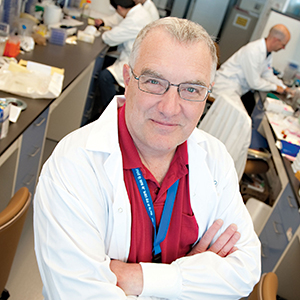Novel research hub geared to improve Canada’s pandemic preparedness and help companies commercialize vaccines
A new kind of research and innovation hub will better prepare Canada for the next pandemic while also helping companies commercialize new vaccines and other therapeutics for many diseases, say members of the Canadian Pandemic Preparedness Hub (CP2H).
The hub is a network that brings together industry, academia, government and health care institutions to expand Canada’s capacity to develop and bio-manufacture vaccines and therapeutics to prevent and respond to emerging health threats.
The hub is co-led by the University of Ottawa (in partnership with The Ottawa Hospital) and McMaster University.
 “Our network has an opportunity to create medicines for Canadians both during pandemic and non-pandemic times,” said Dr. John Bell (photo at left), professor at uOttawa, program director at the Ottawa Hospital Research Institute and co-director of CP2H. “That allows us to be sustainable and really hone our skills in biomanufacturing.”
“Our network has an opportunity to create medicines for Canadians both during pandemic and non-pandemic times,” said Dr. John Bell (photo at left), professor at uOttawa, program director at the Ottawa Hospital Research Institute and co-director of CP2H. “That allows us to be sustainable and really hone our skills in biomanufacturing.”
The idea behind CP2H’s creation was to integrate and coordinate key research and biomanufacturing facilities and health care institutions across Canada, and connect them though ongoing collaboration with the life sciences industry, government agencies and non-government organizations, Bell told a webinar co-presented by uOttawa and Research Money.
CP2H’s network includes research groups and facilities at uOttawa, McMaster University and Dalhousie University, along with the Biologics Manufacturing Centre in Montreal and BioCanRx, Canada’s Immunotherapy Network based in Ottawa.
The University of Saskatchewan’s Vaccine and Infectious Disease Organization, which has unique capabilities to study very large animal models through to clinical trials and biomanufacturing, is also a CP2H partner. The full list of network partners is available on CP2H’s website.
“The agility we have through our multiple facilities and institutions will allow us to make sure we put the best [technologies] forward for Canadians in the event of a pandemic,” Bell said.
“But in the absence of a pandemic, we’ll continue to work on therapeutics for cancers, rare diseases – all sorts of [diseases],” he added.
 “CP2H is very much structured as a network, bringing together extensive GMP (Good Manufacturing Practices) biomanufacturing, drug development, and clinical evaluation expertise and experience,” said Dr. Stéphanie Michaud (photo at right), president and CEO of BioCanRx.
“CP2H is very much structured as a network, bringing together extensive GMP (Good Manufacturing Practices) biomanufacturing, drug development, and clinical evaluation expertise and experience,” said Dr. Stéphanie Michaud (photo at right), president and CEO of BioCanRx.
BioCanRx invests in developing novel cancer immunotherapies and increasing the number of early-phase clinical trials.
“[The hub] really gives us the opportunity not just to procure better [counter-measures] for the next pandemic, but to serve as catalysts for the Canadian life sciences ecosystem in a way that I think is fundamentally different than anything that’s been done before,” said Dr. Matthew Miller (photo at left), executive director of the Global Nexus health innovation accelerator and the Michael G. DeGroote Institute for Infectious Diseases at McMaster  University and co-director of CP2H.
University and co-director of CP2H.
“The hub leverages our collective strengths rather than trying to duplicate them,” he said. “We’re not looking to duplicate services offered by the private sector We’re looking to fill the gaps.”
A chief motivation for bringing together all the various institutions and facilities was to ensure the network could cover the entire gamut of different types of biomanufacturing and technologies, from cell-based therapies and viral vector vaccines to more traditional inactivated vaccines (“killed” vaccines made from a protein or other small pieces taken from a virus or bacteria), Miller said.
“The more work we’re doing to support new discoveries in cancer, metabolism, rare diseases and genetic disorders, the better we will be positioned to respond in the context of a new health emergency, because those platforms are so adaptable,” he added.
“Ultimately what makes us better prepared for pandemics is [having] a healthy, resilient, robust life sciences ecosystem across disease indications.”
New hubs are part of multi-pronged approach to pandemic preparedness and public health emergencies
In January 2022, the federal government created the Centre for Research on Pandemic Preparedness and Health Emergencies within the Canadian Institutes of Health Research, with a mission to grow Canada's capacity to research and mobilize knowledge to prevent, prepare for, respond to and recover from existing and future pandemics and public health emergencies.
The Expert Panel for the Review of the Federal Approach to Pandemic Science Advice and Research Coordination said in its report (the “Walport report”) that the panel heard repeatedly that a more robust interdepartmental and intergovernmental undertaking is required to achieve this critical mission.
In 2023, the federal government created five federally funded research hubs, including CP2H, across Canada through the integrated Canada Biomedical Research Fund and the Biosciences Research Infrastructure Fund.
In September this year, the government also launched Health Emergency Readiness Canada, a new federal agency to provide a sustained focus on growing innovation and industrial capacity in the life sciences and biomanufacturing sector to support Canada’s health emergency readiness.
 In creating CP2H, its members were very conscious of what the gaps were in Canada’s pandemic preparedness and ability to respond to emerging health threats, said Dr. Scott Halperin (photo at right), professor of pediatrics and microbiology and immunology at Dalhousie University and director of the Canadian Center for Vaccinology.
In creating CP2H, its members were very conscious of what the gaps were in Canada’s pandemic preparedness and ability to respond to emerging health threats, said Dr. Scott Halperin (photo at right), professor of pediatrics and microbiology and immunology at Dalhousie University and director of the Canadian Center for Vaccinology.
Dalhousie is one of only two universities in Canada (the other is McGill University) with a “challenge unit,” an inpatient facility where health volunteers can be exposed to a pathogen. This is done to better understand the pathogenesis of the organism, the immune response to that organism, and ultimately to be able to test novel therapeutics such as anti-viral medicines in a very controlled environment.
“Our role within CP2H is to establish and expand on the work we’re doing in our challenge unit and also to facilitate and manufacture the pathogens that are going to be used in these studies,” Halperin said.
The benefit of a challenge unit approach – especially during a pandemic or emerging national health emergency – is to accelerate the understanding of the safety and effectiveness of novel vaccines and other medicines.
The challenge unit approach is much faster, cheaper and can be done with far fewer people compared with a conventional Phase 3 clinical study, which involves multiple centres and typically several thousand patients. Such large studies were necessary for developing and testing the mRNA vaccines against COVID-19.
Another crucial component in the continuum from ideation and academic research to a commercial product is being able to manufacture the product at industrial scale. That’s the role of the Biologics Manufacturing Centre within CP2H.
 “The centre is a one-of-a-kind manufacturing facility in Canada,” said Isabelle Caron (photo at right), president and CEO of the centre.
“The centre is a one-of-a-kind manufacturing facility in Canada,” said Isabelle Caron (photo at right), president and CEO of the centre.
The facility is capable of manufacturing, analyzing and testing cell-based biologics products ranging from vaccines to diverse therapeutic proteins, especially for vaccines and therapeutic candidates maturing in clinical phases up to commercial approval.
“Our role within CP2H is unique because we’re the only GMP-licensed biomanufacturing facility sitting at the table having the ability to produce [these products],” Caron said.
The centre, with its industrial-scale equipment and processes, will be able to fast-track novel products to market and also – being involved in the early stages of the biomanufacturing process – help de-risk the products and accelerate their scale-up.
“When the next health emergency arises, our role is to provide a domestic manufacturing capability to manufacture the needed counter-measures,” Caron said. “This helps ensure that commercialization of innovations stay in Canada.”
uOttawa’s Bell noted that during his career, he has seen “a lot of great ideas just disappear south of the border.”
Startups with promising products often run into problems accessing biomanufacturing equipment of sufficient scale in Canada and have to go outside the country to scale up their products.
“What we’ve come to recognize is that biomanufacturing is one way you can help to cement companies in Canada and grow them here,” he said.
Academic partners in CP2H have positioned their facilities to provide SMEs with the early-phase materials they’ll need to make products. Academic institutions also have designed their infrastructure and technologies to be scalable to the Biologics Manufacturing Centre.
“This will really help SMEs in Canada get a process that they can use to make a product and have a pathway through to commercialization,’ Bell said.
CP2H and other hubs build on existing strengths and collaborations
“That continuum [of product development] is very important,” Halperin said. “Everything that needs to be done to develop a product needs to be done in Canada at reasonable scale and with timeliness, which is the important part for pandemics.”
Another CP2H partner is the Canadian Immunization Research Network, funded by the Canadian Institutes of Health Research and the Public Health Agency of Canada. This network is specifically set up to test the efficacy and safety of novel vaccines and monitor them – including during a pandemic.
The Canadian Immunization Research Network’s Clinical Trials Network (CTN), which was involved in Phase 1, 2 and 3 studies for the COVID mRNA vaccines, is also a CP2H partner. Along with being able to conduct rapid clinical trials, CTN is involved in the social evaluation and public acceptance of new vaccines.
“All of this is very much consciously integrated into CP2H and the other [four] hubs in order to make sure that vaccines not only can be developed in a timely fashion in Canada, but can be used,” Halperin said. “Developing a vaccine that’s not used is no better than not developing a vaccine at all.”
As for CP2H’s capacities and strengths, Miller pointed out that Frank Graham and Jack Gauldie at McMaster University made the fundamental discoveries that allowed for adenoviruses (which cause symptoms similar to the common cold or flu) to be used as vectors for vaccines.
They also made 293 cells, a cell line used in most biological laboratories in the world and frequently used in GMP manufacturing to produce therapeutic proteins and viruses for gene therapy.
McMaster’s researchers have also developed an inhaled vaccine against COVID 19. The research team received $2 million from a Canadian Institutes of Health Research rapid response initiative at the beginning of the pandemic in the spring of 2020.
“In 18 months, we went from drawing the idea for this vaccine on a white board to approval for a Phase 1 clinical trial,” all for at least 10 times less the cost of a typical vaccine-development approach, Miller said.
“The reason that could happen is because all of these pieces were united,” he said. “When all of those pieces fit together, that runway and the ability to do transformational things really quickly shortened significantly.”
“It really epitomizes how what we are trying to create with CP2H can really amplify and transform the product development pathway,” Miller added.
Halperin noted that with concern growing about avian influenza A(H5N1), commonly known as “bird flu,” pre-pandemic vaccines have been approved in the U.S. and are being stockpiled. Canada hasn’t yet decided whether to do the same.
However, “CP2H is there to facilitate whatever Canada decides, whether it be pre-clinical work or through to Phase 1 studies,” he said.
Last week, the Canadian Institutes of Health Research announced a $5.2-million investment, in collaboration with other federal and provincial partners, for 35 research projects aimed at helping Canada prevent, prepare for, recover from and respond to outbreaks of avian influenza.
These projects will enable research on the most time-sensitive evidence gaps and immediate research needs related to the current outbreaks of avian influenza in animals and the risk of further transmission to human populations.
Creating a “sticky” life sciences ecosystem that attracts investors
Miller said what everyone learned during the COVID pandemic is that preventing pandemics is a very multidisciplinary endeavour that requires a one-health approach.
McMaster and CP2H’s other academic partners are formalizing collaboration with industry partners in areas that encompass everything from prophylactic interventions to vaccines to new diagnostic assays, he said.
The five hubs across Canada also interconnect because many have shared partners involved in multiple hubs, and the hubs have complementary strengths, focuses and expertise, he added. “Every hub brings a unique core strength that allows us to make sure that we have coverage over the [pandemic] preparedness but also from an expertise perspective.”
“We’re focused on enhancing Canadian health generally speaking across all disease indications,” including providing Canadians with access to new opportunities to treat cancer, metabolic disease, genetic disease and other diseases, Miller said.
“And in doing that, we will become prepared very organically [for the next pandemic or national health emergency].”
For example, he added, “If we want to prevent pandemics from happening, the best way to do that is to protect ourselves at the human-animal interface, because pandemics happen when new diseases spill over from animals.”
The Saskatoon-based Vaccine Infectious Disease Organization, a CP2H partner, has deep expertise in producing veterinary vaccines including to protect food chains, Caron said. “The next pandemic could touch the animal kingdom that we are using as food and it will then become a health crisis for us as humans.”
Caron said CP2H is focused on developing innovation with potential to be commercialized and fostering a growing, diverse and resilient ecosystem.
That is going to create “stickiness” within Canada’s life sciences ecosystem, which will be much more attractive to private investors and international investment, she said. “The whole idea behind creating that solid pipeline of innovation is that it has the potential to really become commercial product and is going to lead to more private investments.”
However, Miller noted that when it comes to emergency preparedness, some of the most important gaps in Canada are policy gaps.
During the COVID-19 pandemic, the lack of clarity around how non-pharmaceutical public health measures were implemented – such as limitations on capacity and social circles and which businesses were closed versus open – confused many people, he said.
Currently, Canadian policymakers are wrestling with whether to implement a pre-pandemic vaccination program against avian flu and, if so, when and for whom.
“One of the things that we [with CP2H] can really help support, in addition to biomedical countermeasures, is in helping fill some of these policy gaps,” Miller said.
For example, he is a member of several key committees, including the Canadian National Advisory Committee on Immunization COVID-19 Working Group and Committee, the Federal Variants-of-Concern Leadership Group, the Federal Pandemic Science Coordination and Action Group, and the Public Health Agency Canada Expert Panel on Highly Pathogenic Avian Influenza. Caron is co-chair of the Canadian Chamber of Commerce’s Life Sciences Strategy Council, so she is well connected to the life sciences industry.
Canada has a lot of geopolitical and demographic strengths that make the country a very attractive place to do business and do scientific and clinical development work, Miller said.
“Rather than sort of thinking small, which we as polite Canadians are prone to doing, we also need to be thinking about how these unique resources and investments set us up to be a resource for other places in the world.”
R$
Events For Leaders in
Science, Tech, Innovation, and Policy
Discuss and learn from those in the know at our virtual and in-person events.
See Upcoming Events
You have 1 free article remaining.
Don't miss out - start your free trial today.
Start your FREE trial Already a member? Log in
By using this website, you agree to our use of cookies. We use cookies to provide you with a great experience and to help our website run effectively in accordance with our Privacy Policy and Terms of Service.




.png)
